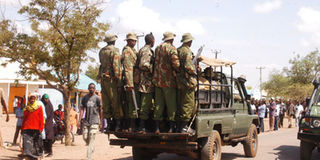Arms race by pastoralists creates a huge market

Police patrol Isiolo town on November 16, 2009 in a bid to disperse people who intended to block Isiolo highway due to insecurity. Fuelled by persistent droughts, the arms race among the pastoral communities in Kenya has intensified in the last decade with almost 95 per cent of households said to own a firearm. Photo/JOSEPH KANYI
The demand for automatic weapons in Turkana, Samburu and Pokot has created a huge market and this could explain the recent arms seizures in the country.
Fuelled by persistent droughts, the arms race among the pastoral communities in Northern Kenya has intensified in the last decade with almost 95 per cent of households said to own a firearm.
A two-decade study of the three communities says that by the early 1990s, most households had a military-issue rifle. Now, it is an AK-47 or other sophisticated rifle.
The study by the University of Arizona was published last week.
Lead researcher Dr Ivy Pike says the violence in the region has a serious impact on people’s daily lives and health.
She cites a 2007 study by Dr Kennedy Agade Mkutu, a former lecturer at the Kenya Institute of Administration, and concludes that the proliferation of small and light arms has opened a vibrant weapons market in the country.
Light weapons refer to heavy machineguns, grenade launchers, portable anti-aircraft guns, portable anti-tank guns, portable missile launchers and mortars of less than 100mm.
The epicentre
Although small by Kenyan standards, the population in question is significant as buyers of new guns and ammunition. The study estimates the region to have about 220,000 Pokots, 150,000 Samburus and 34,000 Turkanas.
Another study by the Intermediate Technology Development cited Wajir as the epicentre of the arms trade, with guns from there finding their way to Nairobi and other urban centres.
Wajir District, says the report by Ruto Pkalya and Mohamud Adan, is seen to have a larger consignment of arms than other districts because of its proximity to Somalia. The researchers identify Somalia, Sudan, Ethiopia, Uganda and corrupt Kenyan security forces as major sources of illegal weapons in Northern Kenya.
Not cheap
The guns do not come cheap, with old ones costing Sh15,000, previously equivalent to one bull, a G3 rifle Sh40,000 or four bulls an AK47 about Sh30,000 or three bulls and the more sophisticated M16 fetching about Sh60,000.
This was before the drought drastically cut livestock prices in arid areas.
The University of Arizona researchers concluded that while young men are killed or wounded by gunfire in raids, women and children also bear a considerable load from the violence.
“Men generally have better health because they travel with the herds and have better access to meat and milk. Women will sacrifice to feed their children and older women will protect young mothers. All women will forego food when their children are hungry,” says the study.




